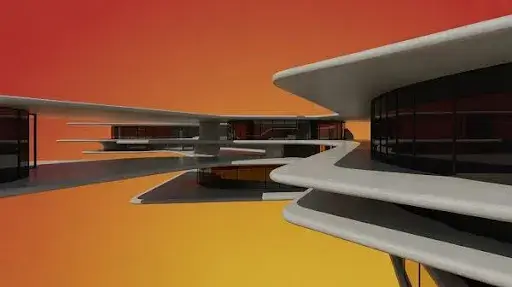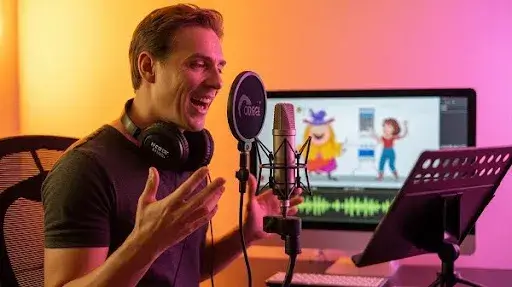When it comes to showing great animation, the details that usually grab attention are the design’s elegance, the large scale of the actions, the character’s flashy features, or any over-the-top parts of animation.
Smooth, natural, and believable transitions are often hidden behind a well-kept curtain called tweening in animation. Well-designed animated characters would still lack life and move like puppets on strings.
This isn’t just a background process for animators. From the tradition of animation to modern software, tweening has stood the test of time. Its evolution alongside technology proves resiliency and strength. Mastering the craft of tweening remains one of the most neglected branches in animation, and in today’s world remains the most misunderstood.
What is Tweening in Animation?
Here’s a quick tweening definition: it’s the process of creating the in-between frames that bridge two key poses. Those main poses — called keyframes — capture the essential points of an action. The process of tweening fills the gap between them, so movement flows naturally.
Fact: The animation market is stable than ever right now with a compound annual growth rate (CAGR) at above 6% through 2028.
Assuming a character is executing a leap from one rooftop to another in the animated world. Tweening is the animated craft of celebrating all the frames in between arms swinging mid-air and legs stretching during a heroic mid-air leap, clothes ripping in the breeze.
Key details:
- Keyframes = starting and ending poses
- Tweens = everything between those poses
- Goal = fluid, believable movement
Even if one considers it to be a secondary task, it is one of the most vital aspects in animation, containing the richness of frames. Flexibility around stretching, subtle tweaking, and spacing all tweak some portion of a scene while the big picture remains the same.
Tweening Characteristics You Should Know
When people ask what is tweening, they often focus only on the definition. But understanding its traits explains why it’s such a cornerstone of animation.
1. The “in-between” visuals
Keyframes grab the spotlight, but tweening is where the magic of motion lives. These drawings might look odd or distorted when viewed alone — stretched limbs, exaggerated curves — but they make the overall animation feel alive when played in sequence.
2. Smooth motion control
All actions are comprised of distinct parts. Without the in-between parts, the movements would be stuttered. In steps like blinking, and in all the way to the gentle motions, the in-betweens need to be placed to the action, and the in-betweens need to be placed to achieve the smooth, realistic feeling.
3. Often handled by newer artists
In traditional animation studios, keyframes are created by a lead animator, and the in-betweens are the work of junior animators and assistants. This is a traditional ‘learn by doing’ model where trainees acquire skills while improving a project’s quality.
The Origins of Tweening
The origins of tweening date back to when every single frame was hand-drawn. It wasn’t optional — it was essential. In the golden era of animation, studios like Disney relied on teams of “inbetweeners” whose sole job was to fill in the frames between a senior artist’s key drawings.
Back then, standard playback rates were either:
- 24 frames per second for full animation
- 12 frames per second for limited animation (holding some drawings for two frames)
Traditional tweening meant stacks of paper, precise timing charts, and endless hours of drawing. There was no shortcut. Every motion arc, every shadow, every overlapping action had to be drawn frame-by-frame.
Even now, the discipline from that era influences digital work. The same principles — spacing, arcs, anticipation — still apply, even if software handles part of the workload.
Types of Tweening Animations
Different projects call for different tweening methods. While the tools have evolved, the two main types remain widely used.
1. Classic Tweening Animations
This is the old-school method, still valued for precise control. In animation programs such as Adobe Animate, classic tweening animations are best for simple 2D animation services. It necessitates placing keyframes and managing properties such as location, angle, and size for each frame.
Classic tweens demand more attention to detail. The animator decides exactly how each frame flows, which means the results depend heavily on skill and experience. The downside? It’s not suited for complex 3D object creation.
2. Motion Tweening
Motion tweening is more flexible and often preferred for interactive media like games and motion graphics. It’s more automated, letting the software generate the in-betweens once you set a start and end position.
With motion tweens, you can animate multiple properties at once — movement, transparency, color changes — and they’re great for animated action with tweening in 3D environments. The animator still controls the path and timing, but doesn’t have to draw each frame manually.
Tweening in Modern Animation
It’s easy to think that in today’s era of powerful software, tweening has lost its relevance. Not true. With respect to the tools that are being used, the importance of tweening in modern animation has not changed, even in the case of modern animation tools, which have undergone significant technological advancements.
Animation programs of this era automate animation tweening, such as Adobe After Effects, Toon Boom Harmony, and Blender. These tools can perform tweening through the process of drawing the in-between frames, which is extremely fast. This is a very useful feature, but there is a downside: without careful adjustment, the inserted frames can appear robotic.
Here’s where skill comes in. The end product is best achieved when animators enhance it through adjusting movement and timing, even when frames are automated. This ensures that the animation is smooth and fluid.
The Process of Tweening: Step by Step
Every studio and animator has their own workflow, but the process of tweening generally follows these steps:
- Create keyframes
Define the starting and ending poses of the action. These should clearly express the motion without any in-betweens yet.
- Plan the motion arc
Motion rarely moves in a straight line unless that’s intentional. Arcs make movement feel natural.
- Set in-betweens
Decide how many frames you need. More frames = smoother motion, fewer frames = snappier action.
- Add secondary motion
Clothing, hair, or other elements that react to the main movement help sell the realism.
- Review and refine
Play back the sequence and adjust spacing or arcs until it feels right.
The Role of Tweening in Traditional Animation
Before software automation, traditional tweening was a grind — but a rewarding one. In the studio pipeline:
- Senior animators handled the keyframes
- Inbetweeners drew all the transitional frames
- Checkers reviewed every sheet for consistency and timing
This division of labor made large-scale production possible. It also trained new artists in timing, spacing, and motion arcs before they moved up to creating keyframes themselves.
In this case, tweening acted not just as a procedural technique but as a device for narrative. Actions, which are a move, a step, or an arm stretch, are precisely controlled in between.
Why Tweening Still Matters Today
Optimization has been achieved to a great extent by automated systems. Even with automation speed benefits, cut-out animations will always seem digital and lifeless. The automation and tech revolution has achieved great feats, but in areas like animation, rigid automation will always be devoid of the result of humanity.
With a few subtleties like an exaggerated arc or an additional frame that aids in building anticipation, an easily forgettable animation is turned into a far more remarkable piece. The same principles of tweening that have been taught for decades are what professional animators still seek.
Common Mistakes in Tweening
The most common reasons for an error stem from automation or cutting corners and will most often result in a lack of mid-frame adjustments.
Straight-line motion for everything
Unless you’re animating something rigid like a train or a sliding door, straight-line movement looks robotic. Characters, animals, and even objects like bouncing balls follow arcs — ignoring that makes animation feel flat.
Inconsistent spacing
If frames are bunched too closely in one section and too far apart in another, the speed of motion will feel unbalanced. This can accidentally make movements jerky.
Ignoring secondary elements
Hair, fabric, and other loose parts should react to the main motion. Without them, the animation looks incomplete.
Over-reliance on automated tweening
Software-generated in-betweens save time, but they often lack personality. Without adjusting timing or easing, you end up with mechanical motion.
Tips for Perfecting Tweening Animations
Strong tweening is about making movement feel natural and intentional. Here are techniques professionals swear by:
1. Follow the Motion Arc
Movement in nature almost always follows a curve. Even a thrown object arcs downward due to gravity. Keeping this in mind ensures the action feels believable.
2. Use Separate Layers
When working digitally, split characters, props, and backgrounds into different layers. It keeps the process organized and prevents unintentional edits to other elements.
3. Control Frame Spacing
The tweening characteristics of an animation depend heavily on how you space frames:
- Tight spacing = slower, more deliberate motion
- Wide spacing = faster, more energetic motion
4. Observe Real-Life Movement
Take a look at videos of animals and objects in motion. The act of observing movements, frame-by-frame, teaches quite a bit about the transfer of weight, how momentum works, and subsequent actions.
Animated Action with Tweening: Real Examples
Tweening isn’t just for subtle movements — it’s also behind many high-energy sequences.
Example 1: Fight scenes
In action animation, it is crucial to use tweening so that blows such as punches or kicks have the right build-up and also include follow-through. Without proper in-betweens, these blows lose weight.
Example 2: Environmental effects
The gentle flow of water, clouds, and trees all require precise in-betweens to maintain the illusion of liveliness without detracting from the central focus.
Example 3: Character expressions
Even micro-movements in a character’s face — a raised eyebrow, a slow smirk — are improved with careful tweening.
Advanced Tweening Techniques
Once you’ve mastered the basics, these methods can elevate your animations:
- Easing: Adjusting how motion accelerates or decelerates creates a more natural rhythm.
- Squash and stretch: Adding distortion to show weight and flexibility.
- Anticipation and overshoot: Taking action, then pulling the automations to rest proportionately past the intended endpoint.
- Follow-through: Secondary parts of the character keep moving slightly after the main motion stops.
These are often layered on top of classic tweening animations or motion tweens to add personality.
Automate Animation Tweening Without Losing Quality
Though automation can streamline workflows, the greatest outcomes are achieved through a careful balance of software and manual finesse.
Good automation habits:
- Let the software handle basic position and scale changes
- Manually tweak arcs and easing for organic motion
- Add hand-drawn in-betweens for complex actions
This strikes a balance by enhancing automation efficiency while still keeping the artistry of traditional tweening.
Why Tweening Skills Boost Your Career
Studios value animators who understand tweening because it shows you know how movement works, not just how to operate software. Freelancers have plenty to gain, too. For freelancers, mastering tweening means they can do more of the work themselves, and that means the costs will be lower and creativity will be high.
Freelancers are able to tween animations and, in turn, are able to prove their abilities and be promoted to the next level. Once a junior animator can produce clean in-betweens, they will be promoted to keyframe animator. The in-betweens will be done with more complexity.
Frequently Asked Questions
Q: What is tweening in animation used for?
This is done to make the animation flow while seamlessly connecting the key components. The lack of tweening structures will lead to animations looking jerky.
Q: What’s the difference between classic tweening and motion tweening?
Classic tweening is more manual and precise, often used for traditional-style animations. Motion tweening is more automated and ideal for interactive or 3D work.
Q: Can you tween without software?
Yes. The same principles of tweening apply to the pre-computer animation world, but be prepared to spend more time on the work.
Q: Is automated tweening bad?
Not at all — it’s a helpful starting point. The key is to refine the automated frames so they look organic.
Q: How many frames should I use for smooth animation?
Achieving fluid animation relies on a target of around 24 frames per second, while drawing 12 will result in stilted movement.
Final Word
Even with the latest developments in technology, pencil and paper, or decades-old software, the fundamental elements of animation have always depended on the process of tweening. The audience perception of any scene is influenced by tweening, be it a peaceful, smooth character moment or a furious, action-packed scene.
Every animation artist wants to stand out. Achieving this level of animation goes beyond the application of the basic principles; it requires a mix of automation and a significant amount of human judgment on a per-sequence level. In a nutshell, the aim is to seamlessly integrate narrative into the kinetic sequences.
For content creators and brands, it is imperative to comprehend tweening, especially when animating concepts, because it distinguishes captivating and lifeless visuals. The heartbeat of animation depends on the skill to tween.
Work with Prolific Studio, one of the best animation companies in New York, and get the most premium tweening in animation services for a market-competitive price.
Related articles:











